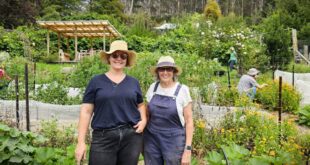
Marion Whitehead with the rare Camellia amplexicaulus. (Photos: Hamish Dunlop, Marion Whitehead)
Story by Hamish Dunlop
What do tea, samurai clans, William McArthur, Benjamin Franklin, Vietnam and the Botanic Gardens at Mount Tomah have in common? Read on to explore the way camellias and cultures are woven together and why it’s important we think about conserving biodiversity as a global project implemented at a local level.
Key Points:
- The Blue Mountains Botanic Garden at Mount Tomah will open a dedicated camellia garden in late 2024
- The garden will be home to some of the rarest and most beautiful camellias from around the world
- The ‘living collection’ is significant in terms of global biodiversity conservation
Marion Whitehead is the Supervisor of Ornamental Gardens and Nursery at the Blue Mountains Botanic Garden at Mount Tomah. She loves camellias with a passion and is enthralled by the intersection between people and plants.
For the last five years, Marion and her camellia-partner-in-crime, Senior Horticulturist, Mitch Carle have been on a mission. They’ve built strong relationships with private collectors and camellia-related organisations and societies across the country. This has enabled them to collect and propagate a wide range of camellia species and cultivars.

The view from the observation deck at the Blue Mountains Botanic Garden. (Photo: Hamish Dunlop)
With a nursery overflowing with plants, everyone at Mount Tomah, including Curator Manager Ashley Filipovski, is excited about the next phase of the project. Thanks to a bequest ten years ago by a camellia-loving Wentworth Falls resident, a dedicated camellia garden has been designed and landscaping is underway.
Marion is thrilled about the stories the garden will tell and the beautiful spaces that will be created. She’s also grateful that the garden’s collecting means that beloved camellias from private collections will live on in perpetuity.
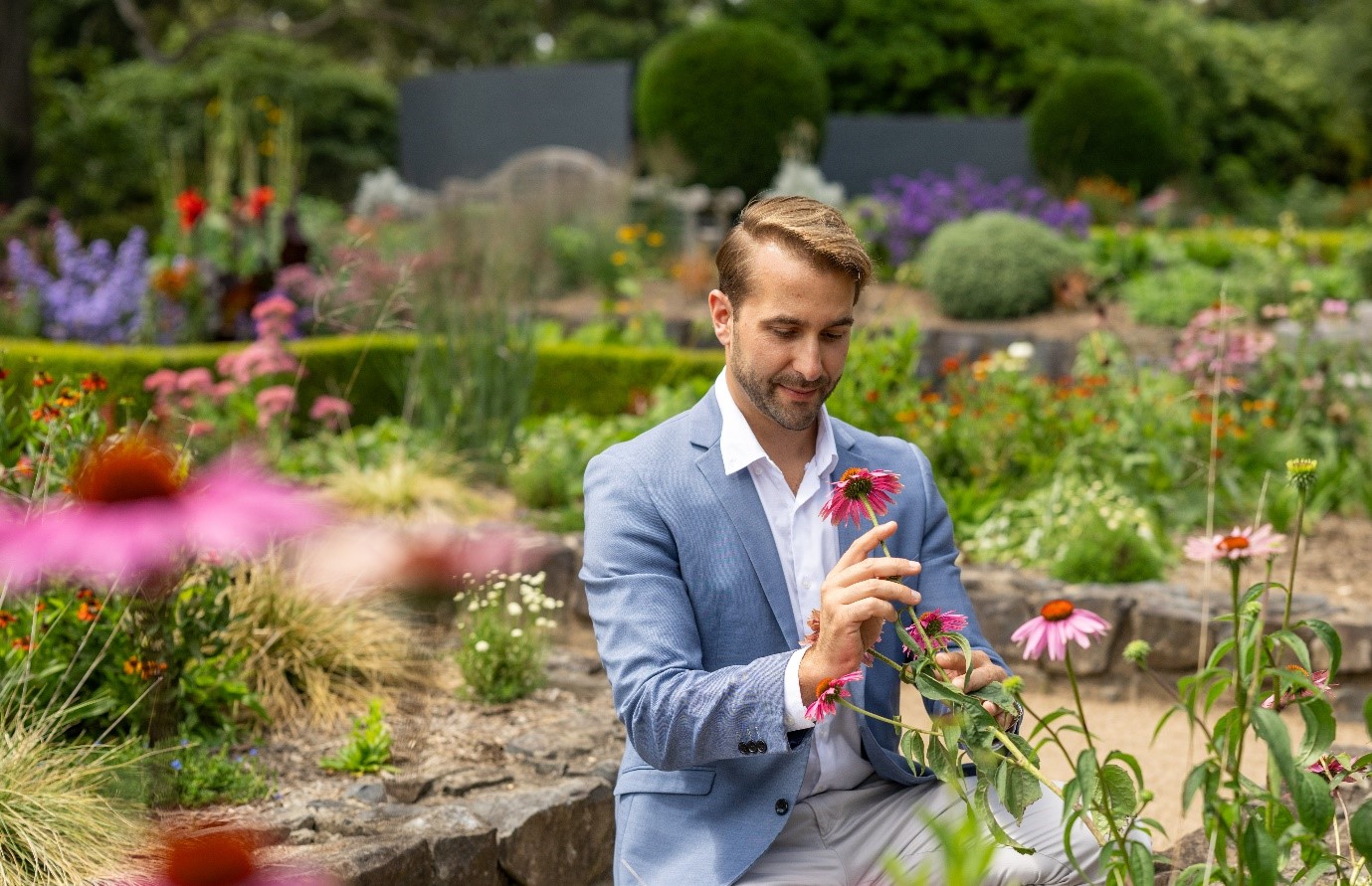
Curator Manager Ashley Filipovski (Photo: Mt Tomah Botanic Gardens)
A camellia collection of global significance
The Blue Mountains Botanic Garden is part of the Botanic Gardens of Sydney. This includes the Royal Botanic Garden in the Domain, Mount Tomah, and the Australian Botanic Garden Mount Annan. Some of the more tropical and subtropical camellias Marion and Mitch have propagated have been sent to Sydney. “It’s hard to let them go,” Marion says. “When you’ve looked after them for years, seeing them every day… But the fact is some of them will flourish in a warmer climate.”
Camellias have been identified as one of the major living collections at the Botanic Gardens of Sydney. Ashley tells me this is for a couple of reasons. “The first is their significance in Australian horticultural history. They were prized in gardens from their first arrival in the 1800s and that enthusiasm continues today.”
As a result of this enduring fascination, Australia has a globally significant collection. “At Mount Tomah we have some of the most beautiful and rare camellias in the world,” Ashley says. Mount Tomah holds two IUCN red listed species in the Theaceae family that are extinct in the wild: Camellia amplexicaulis and Franklinia alatamaha. We have species and cultivars that are listed as critically endangered too.”
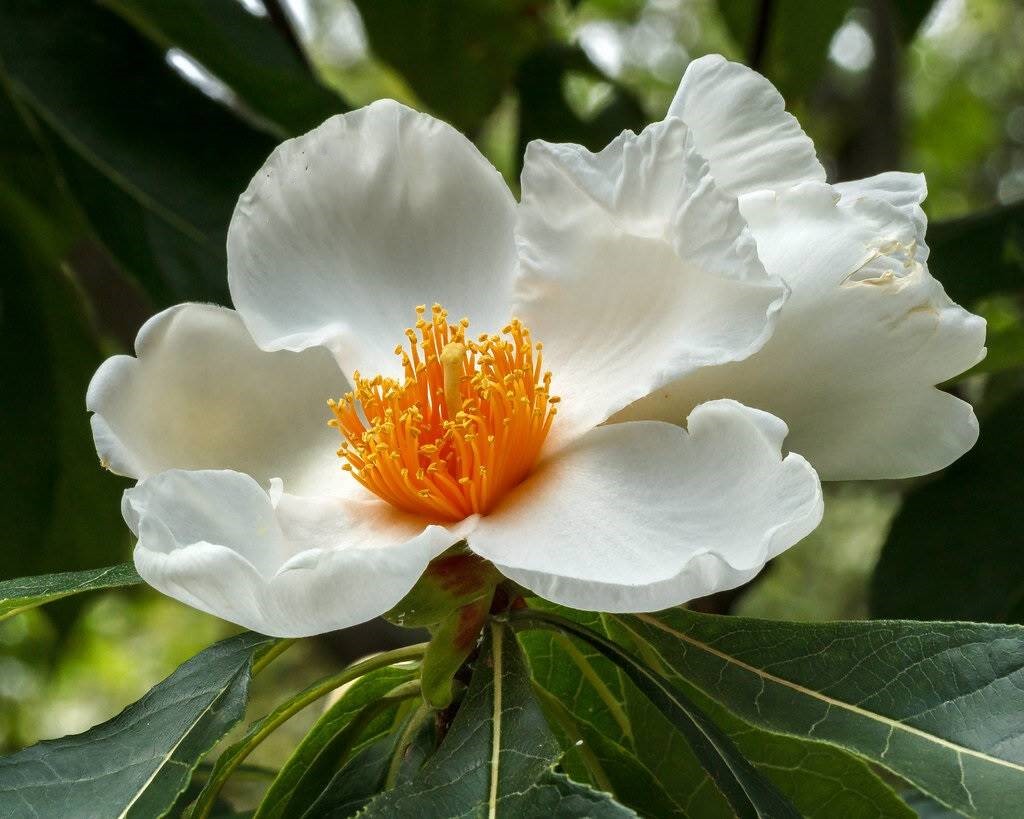
Franklinia alatamaha (Photo: Tom Potterfield)
Damian Wigley is the Manager of Living Collections and Conservation at the Botanic Gardens of Sydney. He explains we need to keep global biodiversity in mind when thinking about local conservation efforts. “Australia is a signatory to the Convention on Biological Diversity which includes a global strategy for plant conservation.”
“Having such a special collection means we have a responsibility to conserve our camellias in support of maintaining global biodiversity. Distributed plant genetics in ex-situ collections like ours act as an insurance policy,” he says. It offers the possibility for countries to reintroduce native plants that may have been lost. “It’s one of the reasons we send six packs of genetically diverse Wollemi Pines to different parts of the world.”

Camellia japonica ‘Yours Truly’ with mutation & Camellia japonica ‘Spring Sonnet’. (Photos: Marion Whitehead)
Australia’s first camellias
The first Camellias landed in Australia in 1823 and entered the collection of the Royal Botanic Garden in Sydney. There were two cultivars, one with brilliant red blooms, Camellia japonica ‘Rubra Plena’, and the tea Camellia. If you’re sipping on a cuppa of black tea as you read this article, you’re likely imbibing a brew made from Camellia sinensis!
The first Camellia cultivar to be bred in Australia was Camellia japonica ‘Aspasia Macarthur’. It was bred by the Honourable Sir William Macarthur (1800 – 1882). Marion says ‘Aspasia Macarthur’ is a really cool camellia.
“Do you know what sporting is?” she asks. “Camellias are famous for sporting. They’ll just produce a random branch that has totally different flowers! ‘Aspasia Macarthur’ has produced eight or nine cultivars in this way. A single plant can sometimes have three different sets of blooms.”
The age of the samurai
Some of the rare Camellia japonica cultivars held by the Botanic Gardens are Higo camellias. Higo camellias originated from an old Japanese Province of the same name; what is now Kumamoto Prefecture on the island of Kyūshū. Marion says Higo camellias are special because individual cultivars were tied to specific families and clans during the Samurai era. The camellia would grow at residences and be planted next to graves.
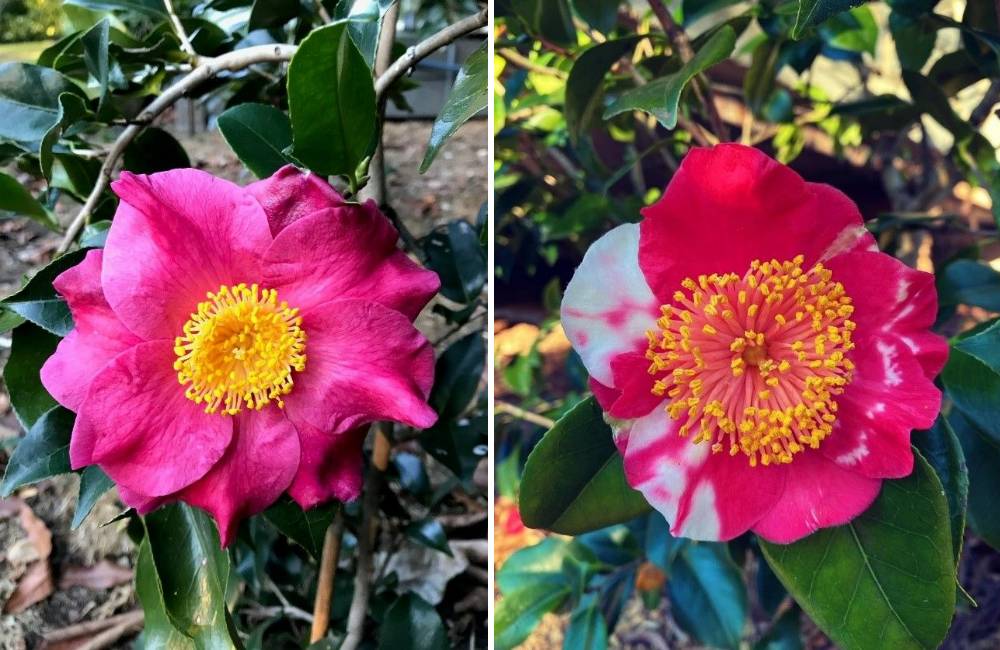
Higo Camellia japonica ‘Hiodoshi’ & Higo Camellia japonica ‘Jitsu Getsu Sei’ (Photos: Mitch Carle)
“The Higo camellias we have come from local collections and from overseas,” Marion says. “The President of the Japanese Gardens Society visited us and was hugely excited. This is part of building positive relationships and creating new connections. The relationship between people and plants is constantly evolving.”
A Blue Mountains local honoured
Marion has recently acquired a new camellia which she is delighted about. Margaret Hamilton was a tour de force in children’s book publishing and a camellia was recently named in her honour. She was also a Blue Mountains local. “I’m friends with Mel, Margaret’s daughter,” Marion says. We were able to get the first specimen made publicly available.
Margaret sadly died before she saw the camellia. When it flowered last season, I sent photos to Margaret’s widower. This year I’ll take some blooms around. It’ll be a special thing to be able to do.”
A race for the ‘holy grail’
As recently as the 2000s, newly described camellias were being sent back to Australia by botanists and camellia enthusiasts. However, in the last few years, biosecurity laws have been tightened. No more camellias will be making their way to our shores. One of the reasons for this is to keep out diseases. Australia is the only country free of camellia blight, a condition where flowers prematurely degrade.

Camellia ‘Kogane Nishiki’ & Camellia nitidissima. (Photos: Marion Whitehead)
Dr. George Orel and Anthony Curry were two of the people two decades ago that were looking for camellias, particularly in South-East Asia. Orel was a lecturer at Western Sydney University. He headed a team that included Clayton Harland, Stephen Jones and Graeme Richards that was searching for a specific camellia: one not seen by science since it was famously described by a French botanist, Jean Baptiste Pierre in the 1860s. In the race against teams from France, Britain and the United States, they found the ‘holy grail’.
“Camellia piquetiana was originally described as having purple flowers,” Marion explains. “When they found it in the wild though, they described it as camellionic!” she enthuses. “The blooms were purple and red and changed colour as you moved around them. It had humongous pendulous leaves 30 to 40 centimetres long that went from a deep purple to a soft green. It’s magical to be able to conserve such a beautiful and rare species.”
Rare in the world
The two rarest camellias at the Botanic Garden in Mount Tomah are Camellia amplexicaulis and Camellia lucii. Camellia lucii was found in a nursery in Vietnam. It was brought back to Australia and grafted. It turned out to be a species not known to science and one no longer growing in the wild. Marion says Camellia amplexicaulis – also listed as extinct in the wild – is cultivated in Vietnam. The flowers are used during the Tết festival that celebrates the arrival of Spring.
Franklinia alatamaha is not in the Camellia genus, but is the only North American member of the Theaceae ‘tea’ family. This is why it has VIP status alongside Camellia amplexicaulis and Camellia lucii. A single plant was discovered in the 1800s by the Altamaha River valley in Georgia in the southeastern United States. The story goes that the person who found the tree and collected seeds was friends with Benjamin Franklin’s family.
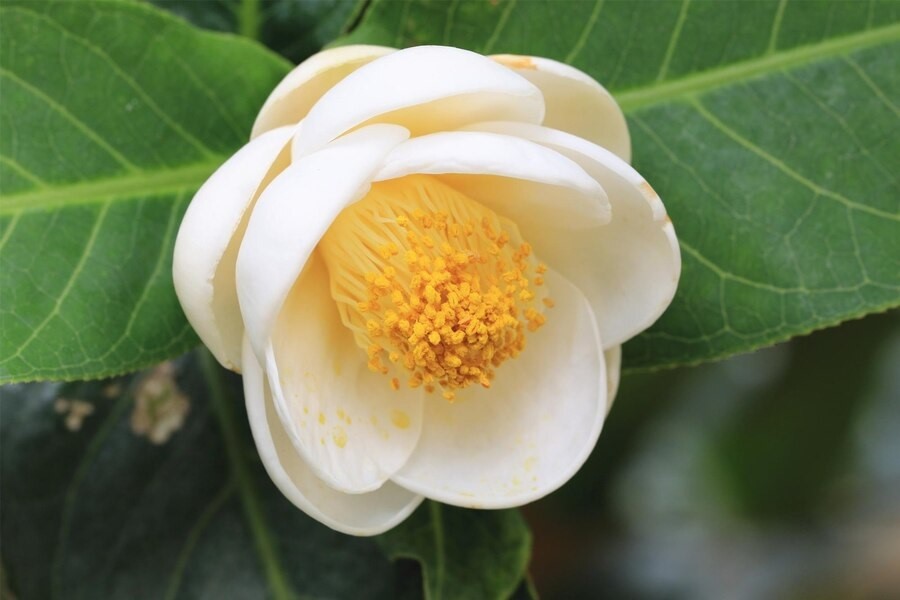
Camellia Lucii (@rosemaryee)
A garden for reflection
Ash says that with the collecting and propagating done, the next stage of the project is to showcase the plants. “It’s a privilege to be able to put the plants centre stage,” he says. “We’ve designed in a Tomah-esque style. Intuitive, overlapping paths, winding through the landscape. There will be basalt columns: cooled lava from the days when Mount Tomah was a volcano. Two of these will be at the entrance of one of the hidden garden areas. Ginkos will drop their butter yellow leaves on the cobblestones. It’s going to be spectacular.”
Marion gestures to a grove of 30-year-old Eucalypts. “Those were originally put in as a wind break,” she says. “Under the canopy we’re going to plant what might be the largest collection of Camellia reticulatas in the Southern Hemisphere. We have the wild species, but also numerous cultivars, some of them rare. They grow to six or seven metres tall and have plate-sized blooms that make a rainbow carpet when they fall.”
“We’re honouring the ethnobotanical history of camellias too,” Marion continues. We have some stone sculptures from Japan such as a facsimile of a tea caddy. Camellias were traditionally a flower of meditation, so we’ve designed in some spaces in the garden for contemplation. There’s going to be a fairy ring for children as well: some tightly packed maples that are easy for children to slip between. Something for everyone,” she says. “A place for stories and beauty to be found.”
Takeaways:
- Botanic gardens are places of beauty and interest with something for almost everyone.
- The network of botanic gardens around the world plays a key role in the fight to conserve global biodiversity.
- The Camellia Garden at Blue Mountains Botanic Garden Mount Tomah will open towards the end of 2024.
Share this article:
This story has been produced as part of a Bioregional Collaboration for Planetary Health and is supported by the Disaster Risk Reduction Fund (DRRF). The DRRF is jointly funded by the Australian and New South Wales governments.
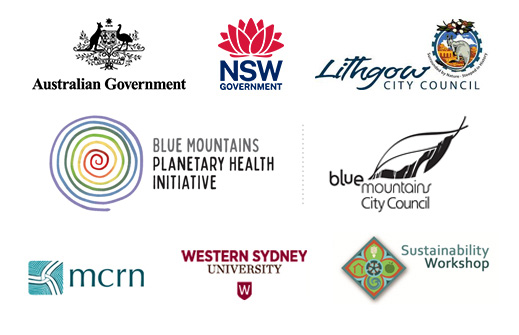
More from around the region
We are thrilled to announce that award-winning health writer and author Sophie Cousins will be leading the workshop: Our Community, Our Stories: Writing for Change from 2-5pm on Saturday 25 May at the Planetary Health Precinct. Sophie`s work has been published in the New York Times, London Review of Books, the Guardian, the Lancet, Meanjin and others. She also works as a public health consultant for the World Health Organisation. The workshop will be followed at 7pm by the launch of the Planetary Health Writers Network. Places are limited so bookings essential (link in profile): https://www.eventbrite.com.au/e/our-community-our-stories-writing-for-change-tickets-895548458547
#writingforchange #impactfulstories #solutionsjournalism #writingworkshop #planetaryhealth #changethestory #thenewsweneed #writersnetwork #bluemountains #katoomba
We`re thrilled to welcome Tamsyn McGrouther to our growing team of volunteer storytellers. She`s reporting on how the Springwood Lot Party transformed an underused space, the car park at Springwood Train Station, into a vibrant community space with food stalls, art opportunities and live music. Read more in Springwood Area Local News (link in profile) : https://springwoodlocalnews.com/springwood-lot-party-2024/
#changethestory #hyperlocalmedia #solutionsmedia #springwood #inspiringstories #planetaryhealth #bluemountains #localnewsmatters
What do tea, samurai clans, William McArthur, Benjamin Franklin, Vietnam and the Botanic Gardens at Mount Tomah have in common? Read our story in Blackheath Area Local News to explore the way camellias and cultures are woven together and why it’s important we think about conserving biodiversity as a global project implemented at a local level. (link in profile) https://blackheathnews.com/camellias-at-blue-mountains-botanical-garden/
@botanicsydney #botanicgardens #mountomahbotanicgardens #camellias #camelliasinensis #tea #samurai #bluemountains #themounts #biodiversity #planetaryhealth
Mushrooms are a hot topic at the moment with more and more research illuminating the essential role these organisms play in the health of the planet as well as the significant health and medicinal benefits they hold for humans. Belle Butler visited local mushroom grower, Alex Felix, at his farm in Lawson to talk about the mighty mushroom. Read more in Mid Mountains Local News (link in profile)
https://www.midmtnslocalnews.com/earthrising-mushroom-farm/
#mushroomgrowkit #mushrooms #fungi #growyourown #lawson #bluemountains
Mushrooms are a hot topic at the moment with more and more research illuminating the essential role these organisms play in the health of the planet as well as the significant health and medicinal benefits they hold for humans. Belle Butler visited local mushroom grower, Alex Felix, at his farm in Lawson to talk about the mighty mushroom. Read more in Mid Mountains Local News (link in profile):
https://www.midmtnslocalnews.com/earthrising-mushroom-farm/
#lawson #mushroomfarming #fungi #mushroomcompost #oystermushrooms #mushroomgrowkit #bluemountains
Maligned through the ages for their association with witchcraft, disease, drug use and poisonings, the fungus kingdom is gaining due credit thanks to ecologists, photographers and foragers. Read more in Katoomba Area Local News (link in profile):
https://www.katoombalocalnews.com/fungi-of-the-upper-blue-mountains/
#fungi #fungus #mycelium #fantasticfungi #bluemountains #planetaryhealth #katoomba #foraging #fungiforaging #fungiphotography #ecology
Yesterday we interviewed physicist Emeritus Professor Hans Coster at Middle Earth in Lithgow. He was in charge of the Sydney Chapter of the Club of Rome and we can`t wait to share with you everything we learnt when we visited him in the home he`s built into a hill in Lithgow. Subscribe to our newsletter via any of our news sites to make sure you get this story! Link in profile.
#nickelironbatteries #middleearth #planetaryhealth #hanscoster
Inspiring reading and a video of Harry Laing`s mesmerising performance of `Time of Fire` in the Blue Mountains Planetary Health newsletter (link in profile): https://bit.ly/3UyytbE
Subscribe to receive this fortnightly via any of our news sites:
Katoomba Area Local News: Fungi of the Upper Blue Mountains
Mid Mountains Local News: The Fun Guy: Earth Rising Mushroom Farm in Lawson
Blackheath Area Local News: A Carnival of Camellias: Beauty and Biodiversity at the Blue Mountains Botanic Garden
Springwood Area Local News: Springwood Lot Party: Transforming an Underused Space Into a Vibrant Community Event
Lower Mountains Local News: Women Helping Women to Survive and Thrive
Lithgow Local News: Fabulous Fungi in Lithgow & the Blue Mountains
@botanicsydney @zontaclubbluemountains
#fungi #fantasticfungi #camellias #zonta #camelliasinensis #springwood #harrylaing #timeoffire
With a bit of tweaking we can reduce how much we need to spend on water and energy. Blue Mountains libraries now stock free-to-borrow ‘My Energy and Water Saver’ kits that Blue Mountains residents can use to assess their homes for energy and water efficiency. Belle Butler borrowed one of the kits and discovered some room for improvement in her Lawson home. Read more in Mid Mountains Local News (link in profile) https://www.midmtnslocalnews.com/saving-power-with-take-home-kits/
@bluemountainscitycouncil
#energyefficiency #waterefficiency #savemoney #savetheearth #freeresource #librariesrock #takeaction #planetaryhealth
Blackheath Public School is providing hands-in-the-dirt lessons on how students can make their school more sustainable. From Crunch & Sip to Cluckingham Palace – literally! – organic waste makes the sunflowers shine and worms frolic in the fertile compost. Students will soon be eating spinach and cheese scrolls made by the canteen using garden produce, while parents report their children want to eat more vegetables. Read more in Blackheath Area Local News (link in profile): https://blackheathnews.com/sustainability-at-school/
blackheathpublic_pandc #blackheathpublicschool #blackeath #bluemountains #sustainableschools #schoolgardens #schoolgardensmatter #planetaryhealth
A fun day yesterday for @bluemountainsplanetaryhealth! In the morning we interviewed and filmed the young people in our Upcycling Fashion Skillshare program. They`re helping create the circular economy we need. In the afternoon we ran a workshop on media skills to help another group of young people learn how to create the news we need, and the news they want to see! They learnt how to use green screen and teleprompter technology as well as skills for interviewing and presenting the news. We`re looking forward to sharing the outcomes! Thank you @heli.jones @kalanigacon @kfmmedia #solutionsmedia #thenewsweneed #upcyclingfashion #planetaryhealth #skillshare #katoomba #bluemountains #pluriversity
Such a fabulous day working with a great bunch of young people to learn how news is made, how green screens work and how to create the news we all need to hear. We can`t wait to see the end result!
#solutionsmedia #thefixingnews #thenewsweneedtohear #greenscreens #mediaproduction #planetaryhealth #skillshare





